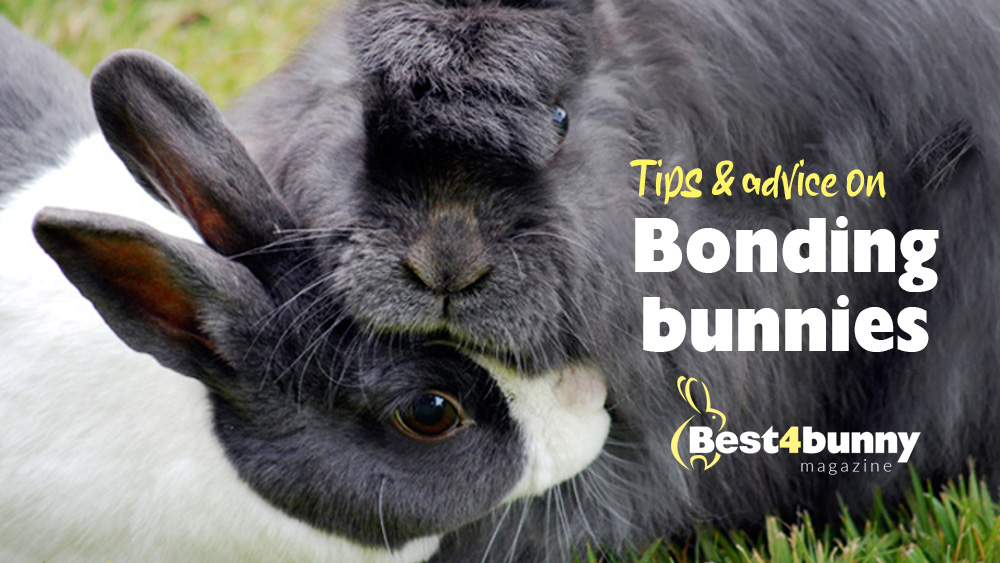
When it comes to bonding rabbits, every bond is different. Some bonds are easy and some are difficult and take a lot longer than others & some just won’t work. Never should you just put the rabbits together and leave them to it, as you are very likely to be left with severely injured rabbits and a huge vet bill. By bonding rabbits the right way and taking the time to do this, you will be more successful. Below is a process we used to bond our bunnies Poppy & Tino. It includes some top tips & we hope it helps others.
##Firstly
**Get each bunny used to the others smell before they meet**
* This is a very good way of introducing them without them meeting, so it’s not such a shock for them when they do meet.
* We gave each bunny a teddy (removed any small parts that could be chewed off like eyes & buttons)
We let the scent of each bunny get onto the cuddly toy and then after a day we swapped them over.
* We continued swapping the teddies throughout the whole bonding process.
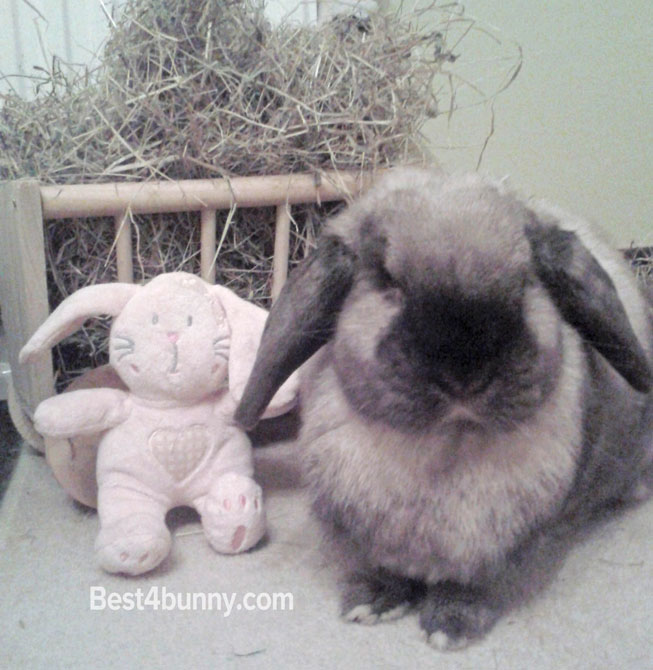
##Then
**Set up their bonding homes**
* Both bunnies homes need to be set up in a neutral area (somewhere each bunny has never been before)
* Poppy was free range in the room, as this is what she is used to and we did not want to enclose her into a cage and cause her stress. Tino was placed in a enclosed large dog crate.
* Everything placed in the room needs to be either new or washed with a vinegar and water solution to remove any previous scents.
* Place litter trays quite far from the others tray. This is to discourage them marking their territory.
* The feeding area for each bunny needs to be placed near to the others. This is to encourage social behaviour between them.
* Both bunnies need to enter their new homes at the same time
**Add protection**
* A puppy pen was unfolded and placed around the dog crate leaving a 2 inch gap. This stops them injuring each other if they try to fight through the sides of the dog crate.
* Attaching galvanised wire to the sides will also help stop any injuries occurring, if you don’t have a spare puppy pen.
##Observe
**Watch how they react with each other. It is very important at this stage to observe their behaviour towards each other**
* If there is no aggression between them – that is a good sign.
* If they seem very relaxed in each others company – that is a good sign
* Ignoring each other is a very good sign
* If they attempt to fight through the railings & run along the sides at each other with their tails up & ears back then this is not a good sign and they are not yet ready for their first date.
* For the first couple of days we used to swap them over into the others accommodation for about 15 minutes. This was to get them even more used to the others smell.
* Observe their behaviour as much as possible over the first 24 hours. If they show no signs of aggression and look very relaxed with each other then you can prepare for their first face to face date.
## Starting the face to face dates
**The area for the dates needs to be another area that neither bunnies have been before**
* We chose the bath tub for this first date to take place. We placed a towel on the bottom of the bath to avoid them slipping & we placed some hay in the middle to encourage social behaviour.
* Having a kitchen sieve with you really helps to protect them from biting each other.
Place the sieve gently in front of one bunny & this allows them to sniff each other without injuries occurring.
* Observe their behaviour towards one another very closely and be ready to prevent any fights starting. It is very important to stop a fight before it starts.
* Look for early signs of aggression. Ears go back and the tail goes up.
* By placing them in a bath tub, it makes it very easy to control them.
* Poppy & Tino ignored each other most of the time (which is a good sign) They got most nervous when one was sniffing the other.
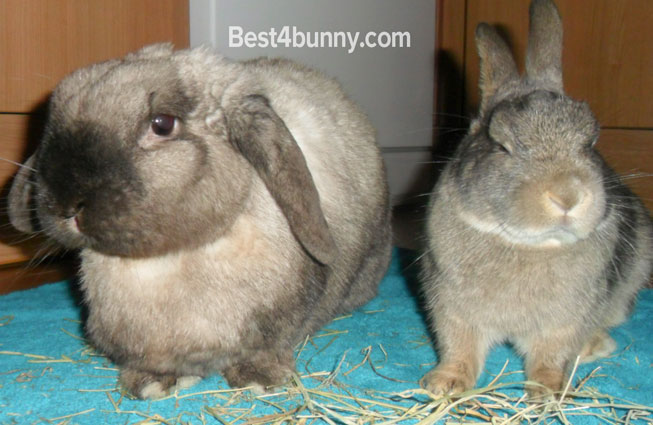
* Keep the meetings about 10 minutes long at first and slowly make the meetings longer once you are happy with their behaviour towards each other.
* Let them meet as much as possible – at least twice a day.
* Slowly increase the area they meet in too. From the bath tub to the bathroom floor, to maybe the hallway. But make sure you can get to them quickly if there is any sudden aggression.
* Always make sure you end the meetings on a good note.
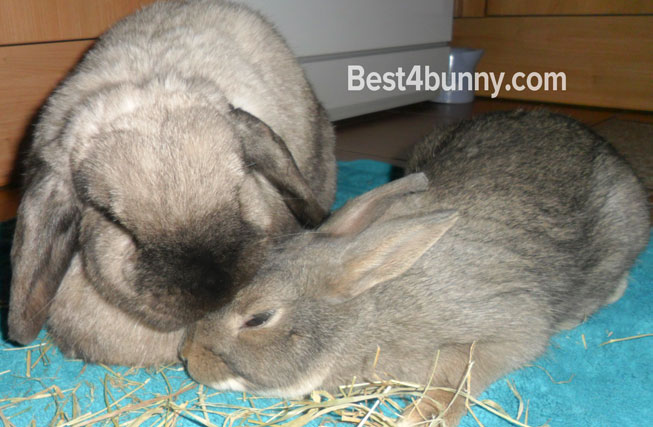
##Finally
**Once you are happy that they can be left for long periods and that there are no signs of aggression, congratulate yourself for successfully bonding your bunnies**
* For their first night together, if possible, sleep downstairs to check all is ok, or keep checking on them on a regular basis.
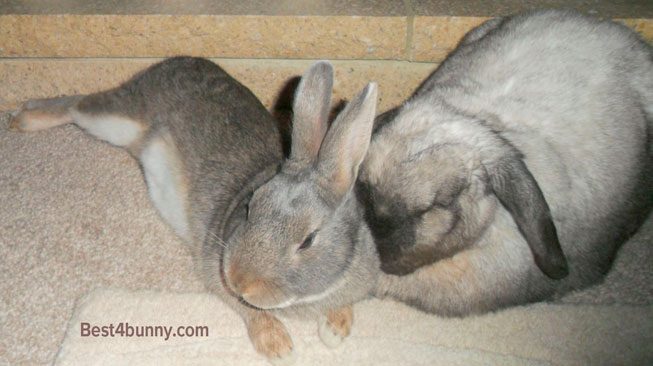
**Tips to help you**
* Don’t forget to talk to them throughout the meeting & give them both lots of nose rubs.
* It is important for you to stay calm & confident when bonding bunnies.
* Throughout the whole bonding process, always make sure they can see each other. Never separate them from sight for long periods as this could upset and confuse them. Also if one bunny has been somewhere different, they could come back with strange smells on them and this could upset the bond.
* If your bonded bunnies will be living in a home that one rabbit previously lived in, you need to wait at least a week until they both move in together and try to remove scents with a solution of water and vinegar. All items in the home need to be new or washed.
* Usually the best pairings for bonding bunnies are a male & female. Same sex bunnies can be bonded, but it helps if they are from the same litter.
* Make sure both bunnies are spayed/neutered before bonding. If you are getting them spayed/neutered, wait 4 to 6 weeks after the operation before you start the bonding. This will give them time for them to heal and for their hormones to settle too.


